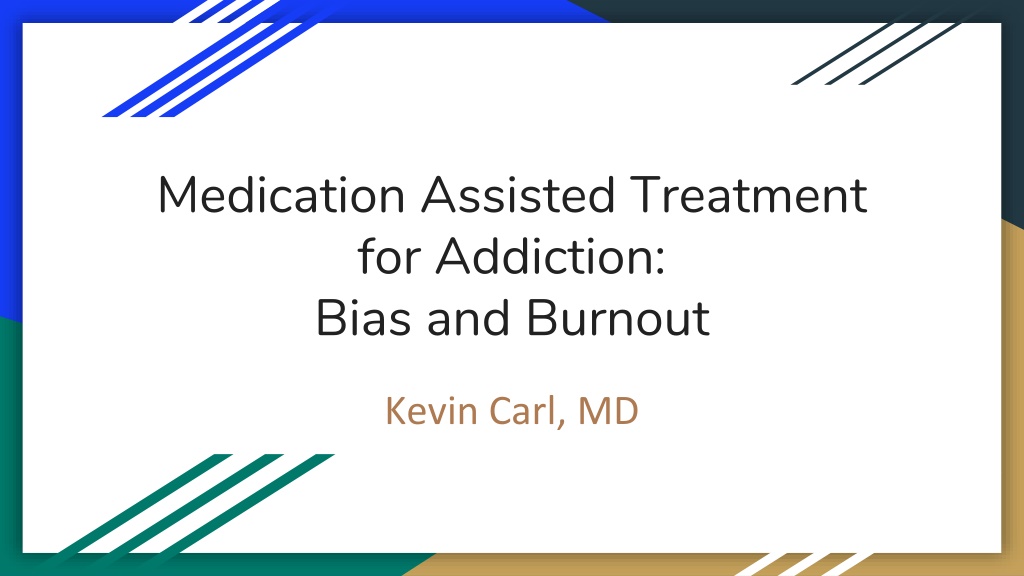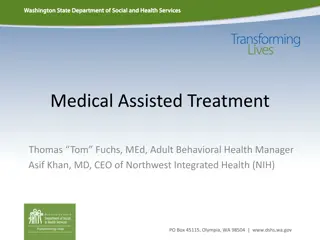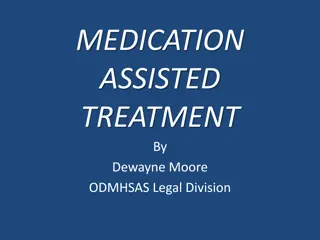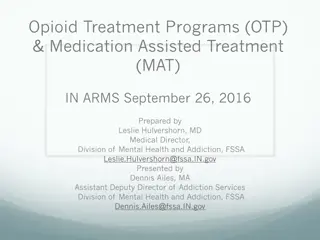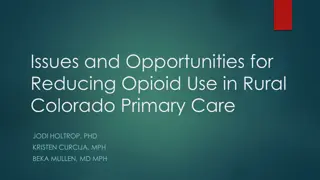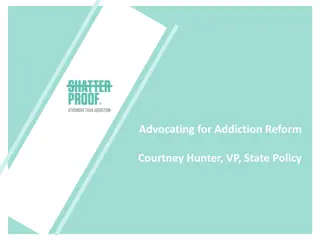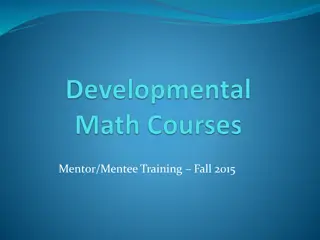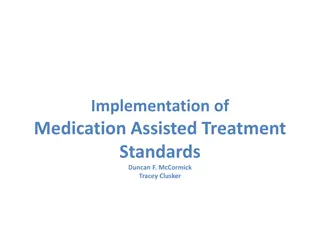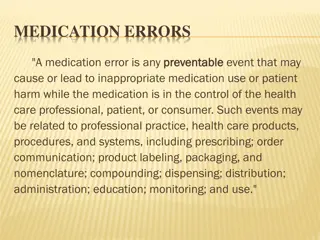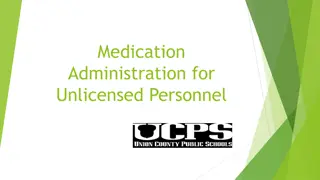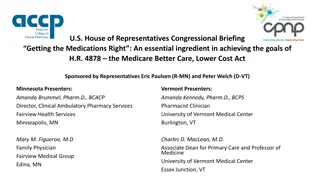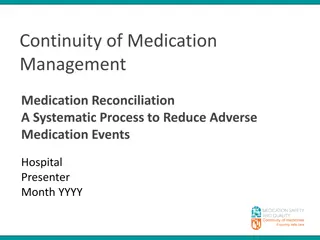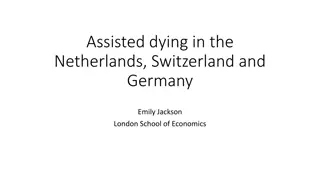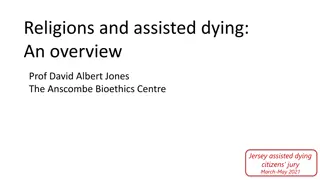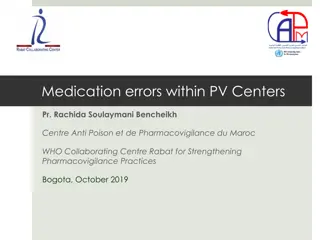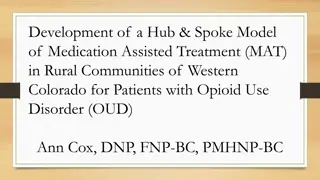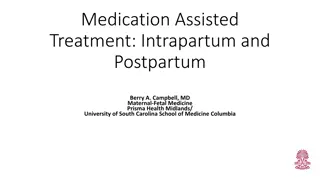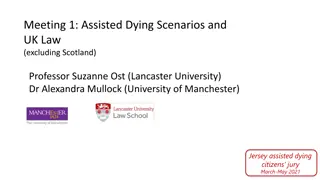Understanding Medication Assisted Treatment (MAT) for Addiction
Medication Assisted Treatment (MAT) combines medications with counseling and therapies to treat substance use disorders. This approach challenges historical biases and stigma around addiction, offering effective options like Methadone, Naltrexone, and Buprenorphine for opioid addiction. Despite biases, MAT has shown significant effectiveness in reducing addiction risks, akin to how Aspirin lowers risks after a heart attack.
Download Presentation

Please find below an Image/Link to download the presentation.
The content on the website is provided AS IS for your information and personal use only. It may not be sold, licensed, or shared on other websites without obtaining consent from the author. Download presentation by click this link. If you encounter any issues during the download, it is possible that the publisher has removed the file from their server.
E N D
Presentation Transcript
Medication Assisted Treatment for Addiction: Bias and Burnout Kevin Carl, MD
What is Medication Assisted Treatment (MAT)? - The use of medications in combination with counseling and behavioral therapies for the treatment of substance use disorders. - Why the special term?
Historical Addiction Treatment - Addiction as moral failing, weakness. - Was and still is largely Self-Help - Few official treatment options - Physical detoxification - Has often been paternalistic and oversimplified
What is Medication Assisted Treatment (MAT)? - The use of medications in combination with counseling and behavioral therapies for the treatment of substance use disorders. Pharmaceutical tools that assist the person with a substance use disorder to achieve meaningful recovery. - - Recovery vs. Sobriety
Bias - Addiction is about choices and willpower. Just don t pick up! - MAT is a crutch - you need to learn to walk on your own.
More Bias - Some of the strongest opposition to MAT comes from treatment providers and people in recovery! - What worked for me should work for you.
Side Note - We will focus on MAT in general, and MAT for Opioid Addiction. - Nicotine - NRT Gum, Lozenge, Spray, Bupropion (Wellbutrin/Zyban), Chantix - Alcohol - Disulfram (Antabuse), Acamprosate (Campral), Naltrexone (ReVia) - Cocaine - ?Topamax, ?Vaccine - Marijuana - None
MAT for Opioid Use Disorders - 3 effective options: - - - Methadone - Opiate Naltrexone (Revia pills, Vivitrol shots) - NON-Opiate Buprenorphine (Suboxone, Subutex, Zubsolv) - Opiate (special properties) - Naloxone (Narcan)
Effectiveness - - MAT for Opioid Addiction: ~25-50% reduced risk Risk without? - After a heart attack: Aspirin reduces further events from 8.2% to 6.7% (1.5% reduction/yr) After a heart attack: Aspirin reduces risk of death from 4.1% to 3.7% (0.4% reduction/yr) Taking Aspirin just to prevent a first heart attack: reduces risk from 0.57% to 0.51% (0.06% reduction/yr) - -
Methadone - - - Methadone is the oldest and most effective treatment for opioid use disorder. It activates opioid receptors in the brain This reduces or eliminates cravings, prevents withdrawal, and makes people feel NORMAL. People remain dependent but not necessarily addicted to methadone. It is risky when mixed with benzodiazepines and alcohol - can be abused. Must be dosed once a day at a specialized methadone clinic (because it is riskier without supervision), and it can be started before you go into withdrawal. Reduces many metrics of personal and public health. - - - -
Naltrexone (Revia pills, Vivitrol shots) - Naltrexone blocks the opioid receptors in the brain. Any opioids given should have no effect. It often reduces cravings for opioids. You must be opioid-free to start, otherwise it will bring on withdrawal symptoms. It comes in a once-daily pill form (ReVia), or a monthly injection that a nurse can administer (Vivitrol). Most people don t feel different (aside from less cravings). Some small risk that people will try to overpower the blockade and OD. - - - -
Buprenorphine - - Buprenorphine partially activates opioid receptors in the brain. For many people, this will reduce or eliminate cravings, prevent withdrawal, and make people feel normal (generally not high). Can be used short term for withdrawal, or as maintenance. People remain dependent on buprenorphine (if you stop it abruptly, you will have withdrawal), but this is different than addiction (which involves a loss of control, cravings, acting against your values, unmanageability, etc). - -
Buprenorphine - Buprenorphine alone is usually very safe, though if mixed with benzodiazepines (Xanax, Klonopin, others) or alcohol it can be dangerous. It must be kept away from children. You must be in moderate withdrawal (12-24 hours from last opioid use) to start buprenorphine, or it can throw you into a bad withdrawal. Doctors must have a special license to be able to prescribe buprenorphine. Studies show buprenorphine effectively reduces or eliminates illegal opioid use, reduces the spread of Hep C and HIV, stabilizes life function, keeps people in counseling treatment, and likely reduces deaths. - - -
MAT Bias - People just want to get high on something legal. - You re just trading one addiction for another. - People are selling/diverting it, and it is getting into the wrong hands. - Methadone clinics and Buprenorphine pill-mills are just full of junkies.
Burnout - Selection bias in the emergency response field. - If you work with people with active SUD s (you do), balance the frustration and burnout by learning from people in recovery.
Final Thoughts DO: DON T: Be Kind Alienate / Demean Be Humble Judge Be Patient Assume
